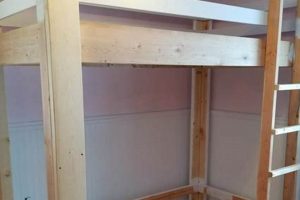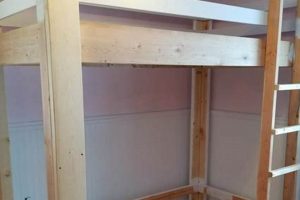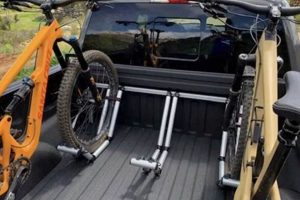A space-saving furniture solution, a fold-down bed integrated with a desk offers multifunctional utility, maximizing room usage, particularly in smaller living spaces. This combination piece allows an area to function as both a workspace during the day and a bedroom at night, providing a practical solution for individuals living in apartments, studios, or multi-purpose rooms.
The rising demand for compact living solutions has fueled the interest in this type of furniture. Its appeal lies in its ability to transform a room quickly and efficiently. By freeing up floor space when the bed is stowed, the desk remains accessible, offering a dedicated work area without the compromise of a permanently placed bed. Historically, similar concepts have existed, but modern designs and readily available hardware have made the construction and incorporation of these integrated units more accessible to a broader audience.
Understanding the component requirements, construction techniques, and safety considerations are all crucial for the successful assembly of such a unit. The following sections will detail the essential aspects involved in planning, building, and installing this functional piece of furniture.
Construction and Installation Tips
The following guidelines offer crucial advice for the successful fabrication and installation of space-saving furniture featuring an integrated fold-down bed and desk. Attention to detail and adherence to safety protocols are paramount.
Tip 1: Accurate Measurement is Crucial: Begin with precise measurements of the designated space. Account for baseboards, moldings, and any other obstructions that could impact the unit’s placement and operation. Double-check all dimensions before cutting materials.
Tip 2: Select High-Quality Hardware: Invest in robust, reliable mechanisms specifically designed for fold-down beds. The hardware should be rated to support the weight of the mattress and bedding, ensuring smooth and safe operation. Consider using slow-close mechanisms to prevent accidents.
Tip 3: Prioritize Structural Integrity: The frame supporting the bed must be constructed from sturdy materials. Consider using hardwood plywood or solid wood for critical structural components. Reinforce joints with screws and wood glue to ensure long-term stability.
Tip 4: Ensure Proper Wall Anchoring: The unit must be securely anchored to the wall studs to prevent tipping or collapse. Use appropriate fasteners designed for the wall type (e.g., drywall anchors, concrete screws). Consult a professional if unsure about wall strength.
Tip 5: Implement a Locking Mechanism: A reliable locking mechanism is essential to prevent the bed from unexpectedly deploying when in the stowed position. This mechanism should be easily accessible and intuitive to operate.
Tip 6: Consider Desk Functionality: Design the desk surface with usability in mind. Ensure adequate legroom when the bed is stowed. Implement cable management solutions to keep the workspace organized and clutter-free.
Tip 7: Thoroughly Test the Mechanism: Before completing the installation, test the fold-down mechanism multiple times to ensure smooth and reliable operation. Adjust hinges and supports as needed to achieve optimal performance.
Adhering to these guidelines will contribute to a safe, functional, and aesthetically pleasing unit. Careful planning and execution are crucial for the longevity and utility of this space-saving solution.
These preliminary steps provide a solid foundation for approaching the more detailed aspects of building and installing the intended piece of furniture.
1. Planning
Planning constitutes the foundational stage in the construction of a fold-down bed with an integrated desk. Neglecting comprehensive planning can result in structural instability, operational difficulties, and potential safety hazards. The direct correlation lies in the fact that the complexity of the design and the precision required for its function necessitate a well-defined plan to mitigate errors and ensure the seamless integration of the bed and desk components. For example, failing to account for the weight of the mattress and bedding during the planning phase can lead to the selection of inadequate hardware, resulting in the bed’s malfunction or even structural failure.
Effective planning involves several critical steps: measurement of the available space, assessment of load-bearing capacity of the wall, selection of appropriate materials, and design of the fold-down mechanism. Consider a situation where a builder proceeds without evaluating wall support. The result could be inadequate anchoring, leading to the unit pulling away from the wall over time. A detailed plan minimizes such risks by identifying potential issues before construction begins, allowing for proactive solutions and preventing costly rework.
In summary, the link between meticulous planning and the successful realization of a fold-down bed with an integrated desk is undeniably strong. Thorough assessment and well-defined strategies are essential to guarantee the longevity, safety, and functionality of this type of space-saving furniture. Overlooking this initial phase can compromise the project’s success and pose considerable risks.
2. Materials
The materials selected exert a direct influence on the structural integrity, longevity, and overall functionality of a fold-down bed integrated with a desk. Inadequate material choices can compromise the unit’s ability to withstand daily use, potentially leading to premature failure or safety risks. A robust frame, for example, is paramount for supporting the weight of the mattress and bedding. If constructed from low-grade particleboard, the frame may sag or break under load, rendering the unit unusable and potentially dangerous. Conversely, utilizing high-quality hardwood plywood or solid wood ensures greater stability and extended service life.
Hardware selection, another critical aspect of material consideration, directly impacts the smooth operation of the fold-down mechanism. Inferior hinges, latches, and support systems can result in jerky movements, difficulty in deploying or stowing the bed, and increased risk of mechanical failure. Opting for heavy-duty, purpose-built hardware designed specifically for fold-down beds guarantees reliable performance and minimizes the likelihood of accidents. Furthermore, the surface finish materials affect both aesthetics and durability. A water-resistant laminate or varnish protects the wood from moisture damage, preventing warping and prolonging the unit’s visual appeal.
In summary, material selection is not merely a cosmetic consideration but a fundamental factor dictating the overall success of a fold-down bed project. Prioritizing quality materials and appropriate hardware is crucial for achieving a functional, safe, and long-lasting space-saving furniture solution. Overlooking this aspect can result in compromised performance, increased maintenance costs, and potential safety hazards. The relationship between material quality and the end product is inextricably linked, requiring careful evaluation during the planning phase.
3. Mechanisms
The operational success and safety of any fold-down bed, particularly those constructed through do-it-yourself methods and incorporating a desk, are inextricably linked to the quality and functionality of its mechanical components. These mechanisms serve as the critical interface, enabling the seamless transition between a stowed, space-saving configuration and a fully deployed bed. Failure to select and implement appropriate mechanisms directly impacts the unit’s ease of use, structural integrity, and overall longevity. For instance, improperly designed or inadequately rated spring or piston systems can result in erratic and potentially dangerous unfolding, posing a significant risk to the user and surroundings.
Beyond the primary fold-down apparatus, considerations extend to locking mechanisms that secure the bed in its stowed position. The absence of a reliable locking system introduces the possibility of unintentional deployment, particularly concerning when the desk is laden with items. Examples of suitable locking mechanisms include spring-loaded latches, magnetic catches, and bolt-action systems, each offering varying degrees of security and ease of operation. Furthermore, the integration of soft-close mechanisms mitigates the risk of abrupt movements, preventing damage to the unit and reducing noise during operation. Correct installation, regular maintenance, and understanding their weight-bearing capacity are critical factors for reliability.
In conclusion, the choice and implementation of mechanisms are not merely an adjunct to the construction of a fold-down bed with a desk, but rather a central determinant of its safety and functionality. A thorough understanding of available options, careful selection based on load requirements and usage patterns, and meticulous installation are crucial for ensuring a secure and convenient space-saving solution. The neglect of these elements can lead to a compromised system, posing both operational challenges and significant safety hazards and understanding their weight-bearing capacity are critical factors for reliability.
4. Construction
The physical creation of a fold-down bed with an integrated desk, commonly undertaken as a do-it-yourself project, represents the culmination of planning and material acquisition. The build phase demands precise execution and adherence to safety protocols to ensure structural integrity and reliable operation. Its connection to the projects overall success is absolute.
- Frame Assembly
The structural framework forms the foundation of the entire unit. This involves cutting materials to specified dimensions, joining components using appropriate fasteners (screws, bolts, and adhesives), and ensuring squareness and rigidity. The frame must bear the weight of the mattress, bedding, and any applied loads during operation. Improper assembly can result in sagging, instability, and potential collapse.
- Mechanism Integration
The fold-down mechanism, typically consisting of springs, pistons, or a combination thereof, must be installed precisely according to the manufacturer’s instructions. Proper alignment and secure attachment are crucial for smooth and controlled deployment and retraction of the bed. Incorrect installation can lead to binding, jerky movements, and premature failure of the mechanism.
- Desk Surface Attachment
The desk surface, which may be fixed or movable, requires secure attachment to the frame. If movable, the mechanism facilitating its movement must be robust and reliable. Consideration must be given to the desk’s weight-bearing capacity and its impact on the overall balance and stability of the unit. Poorly attached desk surfaces can detach or create operational hazards.
- Safety Feature Implementation
Safety features, such as locking mechanisms and soft-close dampers, are critical for preventing accidental deployment and minimizing the risk of injury. These features must be installed correctly and tested thoroughly to ensure their effectiveness. Neglecting safety features can have severe consequences.
Accurate construction techniques are paramount for a secure and functional end product. Deficiencies at this stage can have long-lasting consequences, impacting usability and safety. Therefore, a meticulous approach is essential.
5. Installation
The correct installation is paramount to the safe and functional operation of a fold-down bed with an integrated desk, especially when constructed through do-it-yourself methods. Improper installation can compromise structural integrity, leading to potential hazards and rendering the unit unusable. The subsequent points emphasize the importance of careful execution and adherence to best practices during the installation process.
- Wall Anchoring
Secure attachment to the wall is critical. Locating and utilizing wall studs provides the most robust anchoring point. Appropriate fasteners, such as lag screws or through-bolts, must be selected based on the wall material (e.g., drywall, concrete). Insufficient anchoring can result in the unit pulling away from the wall, posing a significant safety risk. The weight of the unit and any anticipated load (mattress, bedding, desk contents) must be considered when determining the number and type of anchors required.
- Leveling and Alignment
Precise leveling and alignment are essential for smooth and reliable operation of the fold-down mechanism. Any deviation from level can cause binding or uneven weight distribution, leading to premature wear and tear on the hardware. Shims may be used to compensate for uneven floors or walls. Accurate alignment ensures that the bed deploys and retracts smoothly and locks securely in both positions.
- Hardware Adjustment
Following installation, the various mechanical components (hinges, springs, latches) may require adjustment to achieve optimal performance. This process involves fine-tuning the tension of springs, tightening or loosening bolts, and ensuring that all moving parts operate freely without binding. Failure to adjust the hardware properly can result in stiff or erratic movement, increasing the risk of component failure.
- Safety Mechanism Testing
Before regular use, all safety mechanisms (locking latches, soft-close dampers) must be thoroughly tested. This involves verifying that the locking latches engage securely and prevent accidental deployment of the bed. Soft-close dampers should be tested to ensure they slow the bed’s descent smoothly and prevent slamming. Any malfunction must be addressed immediately to prevent injury.
In summary, meticulous attention to detail during installation is crucial for ensuring the safe and reliable operation of a fold-down bed with an integrated desk. Proper wall anchoring, precise leveling and alignment, hardware adjustment, and safety mechanism testing are all essential steps in the process. Neglecting any of these aspects can compromise the structural integrity of the unit and pose a significant safety risk to the user.
6. Safety
The integration of safety measures into the design and construction of a fold-down bed with a desk is not merely a recommendation, but a critical necessity. The potential consequences of neglecting safety considerations range from property damage to severe personal injury. The inherent mechanism of a fold-down bed, involving the movement of a heavy object within a confined space, introduces risks that must be proactively mitigated. For example, a poorly secured bed frame could detach from its mounting, causing the bed to collapse unexpectedly.
Specific safety features, such as robust locking mechanisms, act as preventative measures against unintended bed deployment. These mechanisms ensure the bed remains securely stowed when not in use, preventing accidental release. Equally important is the proper selection and installation of heavy-duty hardware, designed to withstand the stresses associated with repeated bed deployment and retraction. Overlooking these crucial elements can result in a dangerous situation. Stories about unsecured beds that have fallen and injured residents and damaged homes are sadly not uncommon.
The construction of a fold-down bed with a desk requires an understanding of mechanical principles, weight distribution, and secure anchoring techniques. Adherence to established safety guidelines and building codes is essential. It is crucial to inspect it regularly and not overload the desk with weight if the unit has desk. The pursuit of DIY projects, especially those involving complex mechanisms and significant weight, should not come at the expense of prioritizing safety. The long-term well-being of users depends on this commitment.
7. Functionality
Functionality is a central determinant in the successful design and construction of a fold-down bed with an integrated desk. The effective combination of these two distinct pieces of furniture hinges on optimizing their utility within a shared space. The degree to which the unit seamlessly transitions between a workspace and a sleeping area directly reflects its overall value. A poorly designed system may compromise either the desk’s usability or the bed’s comfort, rendering the entire concept impractical. For example, inadequate legroom beneath the desk when the bed is stowed would severely diminish its functionality as a workspace.
Moreover, the ease of transition between the two modes is paramount. A cumbersome or time-consuming process to convert the unit from desk to bed, or vice versa, negates the time-saving benefits. A practical design incorporates intuitive mechanisms and minimizes the effort required for transformation. Furthermore, storage considerations play a significant role. Integrating storage solutions, such as shelves or drawers, within the unit enhances its functionality by providing a space for bedding, work materials, or personal items. This eliminates the need for separate storage units, further maximizing space efficiency.
In conclusion, the functionality of a fold-down bed with an integrated desk is not merely an aesthetic consideration, but a fundamental aspect of its design. By prioritizing ease of use, seamless transition, and integrated storage, the unit becomes a valuable and practical solution for maximizing space in compact living environments. Conversely, neglecting these functional aspects can result in a cumbersome and ultimately ineffective piece of furniture. Therefore, a focus on user-centered design is essential for creating a truly functional and desirable fold-down bed with a desk.
Frequently Asked Questions
The following addresses common inquiries regarding the construction and implementation of space-saving fold-down beds integrating a desk component. These responses aim to provide clarity and guidance for individuals considering such projects.
Question 1: What are the primary space-saving advantages offered by a fold-down bed with an integrated desk?
These units maximize usable floor area by consolidating sleeping and working spaces. The bed retracts vertically when not in use, freeing up the floor for daytime activities. The desk component remains accessible regardless of the bed’s position, offering a dedicated workspace in compact living environments.
Question 2: What level of woodworking experience is required to undertake the construction of such a unit?
Intermediate to advanced woodworking skills are generally necessary. Accurate cutting, precise joinery, and familiarity with power tools are essential. Prior experience with cabinetmaking or furniture construction is highly beneficial.
Question 3: What are the most critical safety considerations during the design and construction phases?
Structural integrity, secure wall anchoring, and reliable locking mechanisms are paramount. The unit must be capable of supporting the weight of the mattress, bedding, and any additional load. All mechanisms must operate smoothly and safely to prevent accidental deployment or collapse.
Question 4: What types of hardware are recommended for ensuring the smooth and reliable operation of the fold-down mechanism?
Heavy-duty, purpose-built hardware specifically designed for fold-down beds is essential. Options include spring-loaded mechanisms, piston systems, and counterbalance systems. Hardware must be rated for the weight of the bed and tested for durability.
Question 5: What are the key factors to consider when selecting materials for the frame and desk surfaces?
Strength, stability, and durability are paramount. Hardwood plywood or solid wood are recommended for the frame. The desk surface should be constructed from a material that is resistant to scratches, moisture, and wear.
Question 6: How can potential issues with installation, such as uneven floors or walls, be addressed?
Shims can be used to compensate for minor irregularities in floors and walls. Careful measurement and precise alignment are critical. Consult with a professional installer if significant structural issues are present.
Proper planning, material selection, and construction techniques are key. Safety must be paramount.
The subsequent section provides guidance on troubleshooting potential issues encountered during construction or operation.
Conclusion
The exploration of “diy murphy bed with desk” projects reveals a complex undertaking requiring careful planning, precise execution, and unwavering attention to safety. The integration of sleeping and workspace functionalities necessitates a thorough understanding of structural mechanics, material properties, and safe installation practices. Success hinges on prioritizing high-quality components, robust construction techniques, and adherence to established safety standards.
Given the inherent challenges and potential risks associated with constructing such a unit, thorough research and, when necessary, professional consultation are strongly advised. The commitment to safety and functionality must remain paramount, ensuring a durable and reliable space-saving solution. The responsible approach to a “diy murphy bed with desk” project benefits the user’s living space and ensures long-term well-being.







